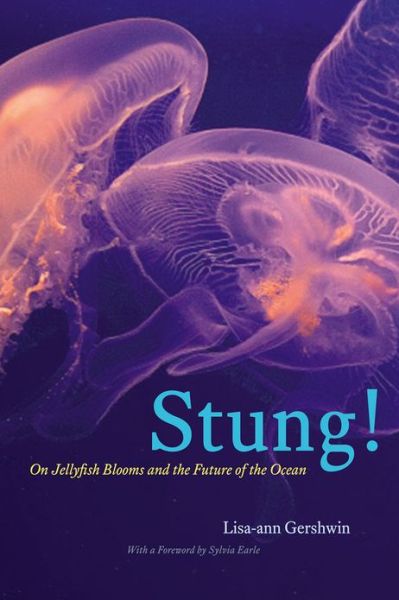
 To contact Chris Winter, send email to this address.
To contact Chris Winter, send email to this address.Copyright © 2013-2023 Christopher P. Winter. All rights reserved.
This page was last modified on 18 August 2023.

| STUNG! On Jellyfish Blooms and the Future of the Ocean Lisa-ann Gershwin Sylvia Earle (Fwd.) Chicago: The University of Chicago Press, May 2013 |
Rating: 5.0 High |
|||
| ISBN-13 978-0-226-02010-5 | ||||
| ISBN-10 0-226-02010-X | 424pp. | HC/FCI | $27.50 | |
All over our water planet, portions of the waters are more frequently being infested with "blooms" (surges in population density) of jellyfish. Many problems result. Jellyfish consume or drive out other creatures in the bodies of water they dominate — creatures like sardines or salmon, on which we depend for part of our diet. They can shut down the cooling systems of ships, nuclear reactors, or desalinization plants. Abundant jellyfish near shore make swimming unpleasant. And of course they sting people — sometimes fatally.
Hence this book by Lisa-ann Gershwin. Director of Australia's Marine Stinger Advisory Services, she has been studying jellyfish for many years. Here she offers up a first course on population ecology, explaining the numerous factors that make jellyfish blooms more common, and more troublesome, than they used to be. Some of those factors are natural, and poorly understood. Others are due to us, and understood all too well. Overfishing is just one example.1
"So many bits and pieces of evidence are around us all the time, but few see them in a connected way. When we think of overfishing, we forget that the warming waters of climate change are reducing the dissolved oxygen, making it harder for fish to respire and survive, and thus further contributing to the loss of fish. When we think of pollution, we think of smelly nasty corners of marinas, or beer cans and plastic drink bottles washed up on beaches, but we don't think about the heavy metals or pesticide residues accumulating in our food supply and our bodies as a result . . . or about the excess nutrients flowing into estuaries and bays, creating vast dead zones . . . or about the many exotic species transported around the world in ballast water every day . . . or about the changes in ocean pH caused by carbon dioxide, leading calcium carbonate to leach out of snails' shells and corals' skeletons. And we hardly ever consider the consequences of jellyfish inheriting disturbed ecosystems—from the jellyfish perspective it is certainly a perfect Hollywood ending, but from the human perspective, it is more like Hitchcock or Poe." – Page 7 |
This is an under-appreciated aspect of the problem. Efforts to save a species often depend on its current population. It is too hard to remember how it once darkened the skies or swarmed the Grand Banks.
The concept refers to how our expectations of what a healthy ecosystem looks like have shifted over time, essentially lulling us into a false sense of security. Because we are familiar only with what we see during our lifetime, historical conditions are never apparent, so reference points of how things used to be shift toward a progressively more degraded state. – Page 263 |
Jellyfish themselves are not a recent problem, of course. They have been around for a long time: fossil impressions show they have lived and bloomed for hundreds of millions of years, changing little in that time. They have not changed because they do not need to change; they are superbly well adapted to the marine environment. Gershwin calls them weeds. It is an apt label, for they are prolific at reproduction and can tolerate conditions that would kill many other species.
The book goes into great detail about several of the most pestiverous varieties of jellyfish. Most notorious, perhaps, is Mnemiopsis leidyi, scourge of the Black Sea. But whatever their species, jellyfish are becoming a persistent problem and might even become an existential threat to human civilization. The fact that the conditions which allow them to thrive to the point of being a threat to us are in large part our own doing only makes carefully considered action that much more urgent.
Gershwin is a thorough researcher and she makes the case for due consideration well. Because of the importance of this message I consider the book a must read. It is, however, difficult to read. One reason is the sheer profusion of detail. Not only does she use the scientific names for jellyfish species throughout the book, but she throws in a lot of numbers: the sizes of fish catches, numbers of jellyfish per cubic meter of sea water, and so on.2 She often describes the same problem several times. Also she cites papers in place. I consider this a good thing, but non-scientists will probably find it distracting. And she would have been well advised to collaborate with a professional writer on this first effort. It's not that she writes badly, herself, but only that another pair of eyes would catch the instances of clumsy phrasing, inappropriate use of punctuation, and similar goofs. For cogency and timeliness I consider it a must read, and the wealth of detail, the photographs, the Appendix, the extensive list of references, and an excellent index make it a keeper for me.

 To contact Chris Winter, send email to this address.
To contact Chris Winter, send email to this address.